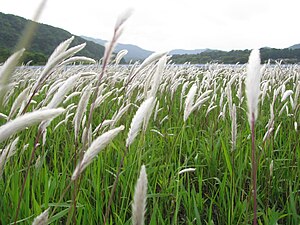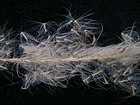Note: This is a project under development. The articles on this wiki are just being initiated and broadly incomplete. You can Help creating new pages.
Imperata cylindrica - Darbha
Darbha consists of root of Imperata cylindrica (Linn.) Beauv. (Fam. Poaceae), a perennial, erect, 30 to 90 cm tall tufted grass, distributed in the hotter parts of India from Punjab southwards.
Uses
Diuretic, Febrifuge, Haemorrhages, Wounds, Infections, Fever, Excess thirst, Nose bleeds, Haematuria, Oedema, Jaundice, Digestive disorders, Indigestion.
Parts Used
Chemical Composition
It Contains five triterpenoids viz. cylindrin, arundoin, fernenon, isoburneol and simiarenol.[1]
Common names
| Language | Common name |
|---|---|
| Kannada | Sanna dabbac hullu |
| Hindi | Daabha, Siru, Ulu |
| Malayalam | Vidulam |
| Tamil | Darbhaipul, Nanal |
| Telugu | Darbalu, Darbha gaddi, Modewa gaddi |
| Marathi | NA |
| Gujarathi | NA |
| Punjabi | NA |
| Kashmiri | NA |
| Sanskrit | Ulu, Kutuka, Kharadarbha, Yajñamūla, Svētadarbha |
| English | Thatch grass, Cogon grass |
Properties
Reference: Dravya - Substance, Rasa - Taste, Guna - Qualities, Veerya - Potency, Vipaka - Post-digesion effect, Karma - Pharmacological activity, Prabhava - Therepeutics.
Dravya
Rasa
Madhura, Kaṣāya
Guna
Laghu, Snigdha
Veerya
Śīta
Vipaka
Madhura
Karma
Tridoṣahara, Rasāyana, Mūtravirecanīya, Stanyajanana, Pipāsāhara, Kuṣṭhaghna, Dāhapraṣamana, Vāmaka
Prabhava
Habit
Identification
Leaf
| Kind | Shape | Feature |
|---|---|---|
| Paripinnate | Oblong | Leaf Arrangementis Alternate-spiral |
Flower
| Type | Size | Color and composition | Stamen | More information |
|---|---|---|---|---|
| Unisexual | 2-4cm long | pink | Flowering throughout the year and In terminal and/or axillary pseudoracemes |
Fruit
| Type | Size | Mass | Appearance | Seeds | More information |
|---|---|---|---|---|---|
| oblong pod | Thinly septate, pilose, wrinkled | seeds upto 5 | Fruiting throughout the year |
Other features
List of Ayurvedic medicine in which the herb is used
Where to get the saplings
Mode of Propagation
How to plant/cultivate
A plant of the tropics and subtropics, where it is found at elevations up to 2,000 metres. It grows best in areas where annual daytime temperatures are within the range 25 - 35°c, but can tolerate 20 - 40°c.[3]
Commonly seen growing in areas
Photo Gallery
References
External Links
- Ayurvedic Herbs known to be helpful to treat Diuretic
- Ayurvedic Herbs known to be helpful to treat Febrifuge
- Ayurvedic Herbs known to be helpful to treat Haemorrhages
- Ayurvedic Herbs known to be helpful to treat Wounds
- Ayurvedic Herbs known to be helpful to treat Infections
- Ayurvedic Herbs known to be helpful to treat Fever
- Ayurvedic Herbs known to be helpful to treat Excess thirst
- Ayurvedic Herbs known to be helpful to treat Nose bleeds
- Ayurvedic Herbs known to be helpful to treat Haematuria
- Ayurvedic Herbs known to be helpful to treat Oedema
- Ayurvedic Herbs known to be helpful to treat Jaundice
- Ayurvedic Herbs known to be helpful to treat Digestive disorders
- Ayurvedic Herbs known to be helpful to treat Indigestion
- Herbs with Roots used in medicine
- Herbs with The ash of the plant used in medicine
- Herbs with Young shoots used in medicine
- Herbs with Young inflorescence used in medicine
- Herbs with common name in Kannada
- Herbs with common name in Hindi
- Herbs with common name in Malayalam
- Herbs with common name in Tamil
- Herbs with common name in Telugu
- Herbs with common name in Sanskrit
- Herbs with common name in English
- Habit - Perennial Herb
- Index of Plants which can be propagated by Seeds
- Herbs that are commonly seen in the region of Impoverished soils
- Herbs that are commonly seen in the region of Sea shore
- Herbs




